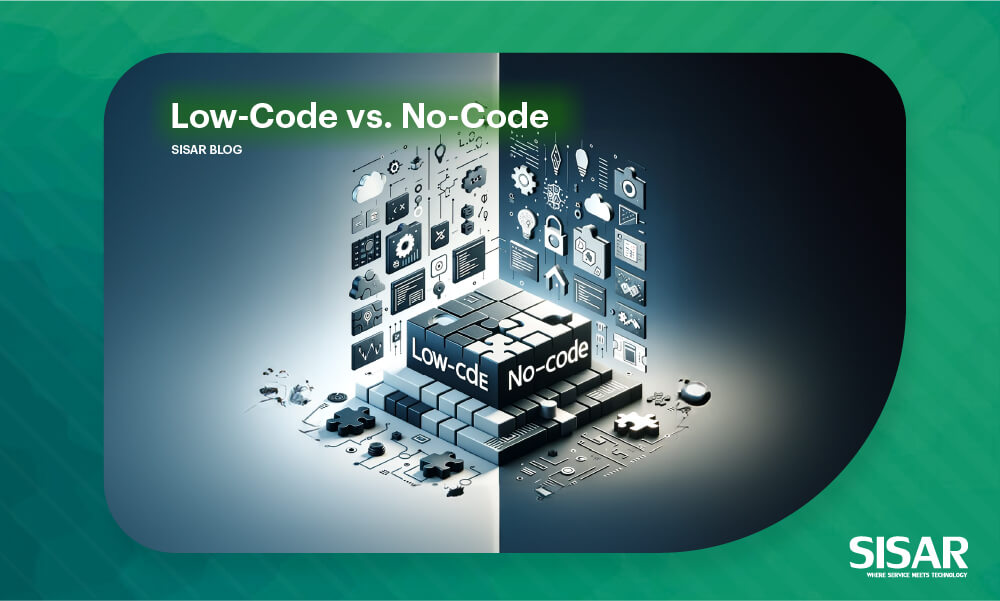In today’s fast-paced digital world, businesses are constantly seeking innovative ways to develop software applications efficiently and cost-effectively.

Low-code and no-code platforms are changing the way organizations create software applications. These platforms enable users to build apps without extensive coding skills. They are making it possible for organizations to develop applications quickly and efficiently.
This guide will compare low-code and no-code development. We will discuss the pros and cons of each approach. We will also determine which one is more suitable for specific projects.
1. Understanding Low-Code Development
1.1 What Low-Code Development Means
Low-code development involves using visual, drag-and-drop functionalities to design and build applications, requiring minimal hand-coding. These platforms typically provide pre-built components and templates that developers can assemble to create fully functional applications rapidly.
1.2 Key Features of Low-Code Platforms
- Visual Development Environment: Low-code platforms offer visual interfaces that allow developers to design application workflows, user interfaces, and data models graphically.
- Rapid Application Development: With reusable components and templates, developers can accelerate the development process, reducing time-to-market for applications.
- Customization Capabilities: Low-code platforms provide pre-built components. However, developers can still create custom functionality and appearance for the application using code when necessary.
- Integration with External Systems: Low-code platforms have built-in connectors or APIs. These tools make it simple to connect with third-party systems and services.
1.3 Pros and Cons of Low-Code Development
Pros:
- Faster Development: Low-code platforms enable rapid application development, allowing businesses to respond quickly to changing market demands.
- Cost-Effective: By reducing the need for extensive custom coding, low-code platforms can lower development costs significantly.
- Accessibility: Low-code platforms democratize application development, enabling citizen developers and business users to participate in the development process.
- Scalability: Many low-code platforms are scalable, capable of handling complex business applications and scaling as the business grows.
Cons:
- Limited Customization: Low-code platforms have limited flexibility. They may not always meet the specific needs of complex or highly specialized applications.
- These platforms may not always be able to cater to the requirements of intricate or highly specialized applications. While low-code platforms are flexible, they may not be suitable for complex or highly specialized applications.
- External Dependencies: Development teams may become dependent on a specific low-code platform. This could limit their ability to switch providers or migrate applications.
- Performance Concerns: In some cases, applications developed using low-code platforms may experience performance issues or challenges with scalability.
- Low-code platforms have their learning curve. While typically user-friendly, developers with traditional coding experience may need to upskill.
2. Exploring No-Code Development
2.1 What is No-Code Development?
No-code development takes the concept of low-code a step further. No-code eliminates the need for any manual coding. Instead, users leverage intuitive, visual interfaces to create applications through a series of simple configurations and settings.
2.2 Key Features of No-Code Platforms
- Intuitive Interface: No-code platforms offer user-friendly interfaces that guide users through the application development process without requiring any coding knowledge. Templated Solutions: No-code platforms often provide pre-built templates. Users can customize these templates and workflows to suit their specific needs.
- Automation: No-code platforms emphasize automation, allowing users to automate repetitive tasks, workflows, and business processes without writing code.
- Access and Collaboration: Similar to low-code platforms, no-code platforms promote easier access and collaboration, enabling business users to participate in application development.
2.3 Pros and Cons of No-Code Development
Pros:
- Accessibility: No-code platforms democratize application development, enabling individuals with no coding background to create functional applications.
- Speed and Efficiency: No-code platforms, let users develop applications quickly. Reduce the time and resources required for traditional development.
- Empowerment of Citizen Developers: No-code platforms empower citizen developers within organizations, enabling them to address their unique business challenges independently.
- Reduced Dependency on IT: By enabling business users to build applications independently, organizations can reduce their reliance on IT departments for application development.
Cons:
- Limited Flexibility: No-code platforms may lack the flexibility and customization options available in traditional development environments or even low-code platforms.
- Complexity of Use Cases: No-code platforms are suitable for simple or standardized applications. But they may struggle to address complex or highly specialized use cases.
- Scalability Concerns: No-code platforms may face scalability limitations when handling large or complex applications or managing rapid growth.
- Integration Challenges: Integrating applications built with no-code platforms with external systems or services may pose challenges because of limited customization options.
3. Choosing Between Low-Code and No-Code
3.1 Considerations for Selection
- Complexity of Project: Evaluate the complexity of your project and the level of customization and control required. Low-code platforms may be more suitable for complex applications with specific requirements.
- User Skill Sets: Assess the technical expertise of your team and the availability of resources. No-code platforms may be ideal for organizations with limited coding knowledge or those seeking rapid prototyping.
- Integration Requirements: Consider the need for integrating your application with external systems or services. Low-code platforms may offer more robust integration capabilities than no-code alternatives.
- Long-Term Strategy: Evaluate your organization’s long-term goals and requirements. Consider factors such as vendor lock-in, scalability, and flexibility when choosing between low-code and no-code platforms.
3.2 Hybrid Approaches
In some cases, a hybrid approach that combines elements of both low-code and no-code development may offer the best of both worlds. Organizations can leverage low-code platforms for complex backend processes and integrations. Conversely, they can use no-code platforms for front-end development and workflow automation.
Conclusion
Low-code and no-code development platforms represent transformative tools that empower organizations to accelerate application development and innovation for great user experiences.
Businesses can gain insights into each approach by understanding the differences between low-code vs. no-code. They do this by considering their strengths and limitations, enabling them to decide which approach best suits their needs.
Whether opting for a low-code, no-code, or hybrid approach, embracing these platforms can unlock new possibilities for digital transformation and business growth. This is particularly crucial in the modern era.






